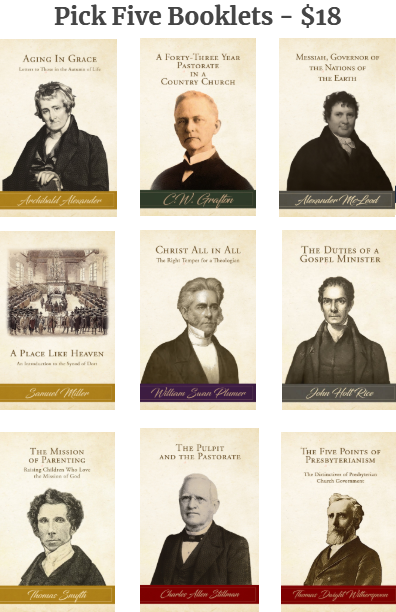(Receive our blog posts in your email by clicking here. If the author links in this post are broken, please visit our Free PDF Library and click on the author’s page directly.)
The Child’s Story Bible [by Catherine Vos] was such a success that it sold more copies than all Geerhardus’s books combined. — Danny E. Olinger, Geerhardus Vos: Reformed Biblical Theologian, Confessional Presbyterian, p. 273
When we think of the most prolific or best-selling writers on Log College Press, names like B.B. Warfield, Archibald Alexander and Samuel Miller may come to mind. But some of the most prolific writers were often pastors’ wives, and, in some cases, as writers, out-sold their husbands. It is worth taking notes of some of their names and stories.
Isabella Macdonald Alden — The wife of Rev. Gustavus Rosenberg Alden, Mrs. Alden was the author of over 200 books, most written under the pen name “Pansy” (a childhood nickname), and contributed as a journalist and editor as well. Her literary fame was world-wide and she received much fan mail, responding to each letter individually. Rev. Francis E. Clark once said, “Probably no writer of stories for young people has been so popular or had so wide an audience as Mrs. G. R. Alden, whose pen-name, ‘Pansy,’ is known wherever English books are read.”
Charlotte Forten Grimké — Both before and after her 1878 marriage to Rev. Francis James Grimké, Charlotte was a poet, diarist and author of articles and essays. Her contribution to African-American literature is still greatly appreciated today.
Elizabeth Payson Prentiss — Mrs. Prentiss, author of Stepping Heavenward, was the wife of Rev. George Lewis Prentiss, author of her biography. Elizabeth wrote dozens of books, as well as poetry and hymns. Stepping Heavenward sold over 200,000 copies in the 19th century, and since a 1992 reprint was issued, at least another 100,000 copies have been sold.
Harriet Beecher Stowe — The wife of Rev. Calvin Ellis Stowe, Harriet is best known as the author of Uncle Tom’s Cabin. But she also wrote around 30 novels, plus articles and letters. She was a celebrity to many, infamous to others, but her writings were an important factor in the momentous events of 1861. Uncle Tom’s Cabin sold over 2 million copies worldwide by 1857 (5 years after its publication) and to date it has been translated into 70 languages.
Mary Virginia Hawes Terhune — Mrs. Terhune, wife of Rev. Edward Payson Terhune, was known by her pen name, Marion Harland. She was the author of many novels, short stories, cookbooks, books on etiquette and more. She gave birth to six children, three of whom survived into adulthood - all three became successful writers as well. Her autobiography contains many fascinating insights into the Presbyterian circles in which she participated in Virginia, such as her remarks on the anti-slavery convictions of Mrs. Anne Rice, wife of Rev. John Holt Rice.
Other prolific female Presbyterian writers, married (whose spouses were not ministers) or unmarried, include:
Pearl Sydenstricker Buck — Mrs. Buck, daughter of a missionary, Rev. Absalom Sydenstricker, and the wife of agricultural missionary John Lossing Buck (until they divorced) and Richard J. Walsh, is well-known for her liberal convictions and for her role in the upheaval that led to Rev. J. Gresham Machen’s departure from the Presbyterian Church in the United States of America. Her 1931 novel The Good Earth won her a Pulitzer Prize, and in 1938 she won the Nobel Prize for Literature in recognition of her writings on China.
Martha Farquaharson Finley — The author of the Elsie Dinsmore series and many more novels, Ms. Finley was a descendant of Samuel Finley and of Scottish Covenanters. Of the Elsie Dinsmore series, it has been said that it was “‘The most popular and longest running girl’s series of the 19th century,’ with the first volume selling nearly 300,000 copies in its first decade, going on to ‘sell more than 5 million copies in the 20th century.’”
Grace Livingston Hill — Niece of Isabella M. Alden, and daughter of Rev. Charles Montgomery Livingston and Mrs. Marcia B. Macdonald Livingston, she was a popular writer of over 100 books on her own, but also compiled the Pansies for Thoughts of her aunt, and they collaborated on other works as well.
Julia Lake Skinner Kellersberger — The wife of medical missionary Eugene Roland Kellersberger, both served the Presbyterian mission to the Belgian Congo. Mrs. Kellersberger wrote many books based on her experience, including a noted biography of Althea Maria Brown Edmiston.
Margaret Junkin Preston — Known as the “Poet Laureate of the Confederacy,” Mrs. Preston was the wife of Major John Thomas Lewis Preston, a professor of Latin at the Virginia Military Institute; the daughter of Rev. George Junkin; and the brother-in-law of Stonewall Jackson. Her literary productions were many, and she was a beloved poet of the South.
Julia McNair Wright — A very popular writer of books for children, including historical novels and introductions to science, and more, Mrs. Wright (wife of mathematician William James Wright), was a remarkable author, whose works were translated into many languages. Her The Complete Home: An Encyclopedia of Domestic Life and Affairs, Embracing all the Interests of the Household sold over 100,000 copies.
These brief notices show that there are a number of popular women Presbyterian writers from the 19th and early 20th centuries. Their bibliographies are lengthy, their legacies in some cases enduring to the present day, and their impact has been culturally significant. The work of adding all of their published writings is ongoing and in some cases far from complete at the present. We hope to make much more progress with each of these writers. The corpus of their literary productions is a real treasure.


